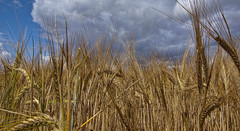
- Image by neilalderney123 via Flickr
It has pretty much become a given that grain crops, such as wheat and barley, need to be started from scratch every spring. This means farmers must buy seeds, use seeding equipment to get those seeds into the soil, then apply a lot of fertilizer and hope for weather conditions that won’t be too hot, cold, wet or dry for germination. There are such things as perennial grains, however – plants that, like the grass in your lawn, simply pick up in the spring where they left off in the fall. While perennial versions of common annual grains have seen little in the way of development, a new research paper says it’s about time they did. The advantages of cultivating perennial grains, the paper’s authors submit, could be one of the biggest advances in the 10,000-year history of agriculture.
The paper, “Increased Food and Ecosystem Security via Perennial Grains,” points out that perennials have longer growing seasons and longer, denser roots than annuals. Those longer roots, which can reach down 10 to 12 feet, allow the crops to reach and hold more water and nutrients, reduce erosion, and condition the soil. Because the plants grow for a greater length of time, they also sequester more carbon from the atmosphere.
Related articles by Zemanta
- Will a Grain Surplus Hurt the Economy? (food.change.org)
- Can one-time tillage improve no-till? (eurekalert.org)
- Agriculture’s next revolution — perennial grain — within sight (eurekalert.org)









